MARIANI’SVirtual
Gourmet
September 30,
2012
NEWSLETTER
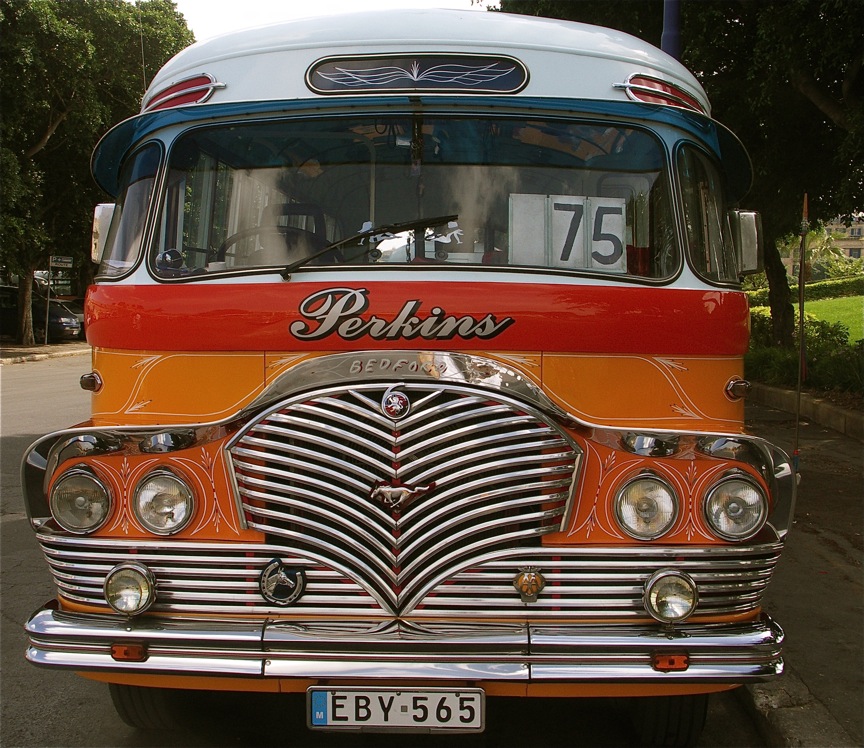
IN SEARCH
OF THE PERFECT
LASAGNE
VERDI AND OTHER GREAT FOODS OF BOLOGNA
By John Mariani
NEW YORK CORNER
JEANNE ET GASTON
by John
Mariani
SWEETS FOR THE SMART
By Brian Freedman
❖❖❖
IN SEARCH OF THE PERFECT
LASAGNE
VERDI
. . . and other great foods of Bologna

By
John Mariani
Pulling down authoritative
Italian cookbooks from my shelf showed I was off
to a bad start.
In her Classic Italian Cook Book (1962),
Marcella Hazan, who is from Emilia-Romagna, uses
two cups of roughly chopped canned tomatoes. Professorial
Tuscan Giuliano Bugialli insists on using chopped
pancetta or
prosciutto and beef broth for the ragù
in Bugialli
on Pasta (1988). I then turned to the
massive, 928-page La Cucina:
The Regional Cooking of Italy by the
authoritative Accademia Italiana della Cucina,
which notes, “Any Italian knows that a cherished
heirloom dish is sure to vary in its preparation,
depending on who is in the kitchen . . .. Thus
while we have strived to present the most iconic
version of key regional dishes, it is up to you,
the home cook, to make them your own”--not a
sentiment you’d ever read in the French culinary
bible Larousse
Gastronomique--followed by a recipe for lasagne verdi
that contains chicken livers, ground beef and
pork, all cooked in butter.
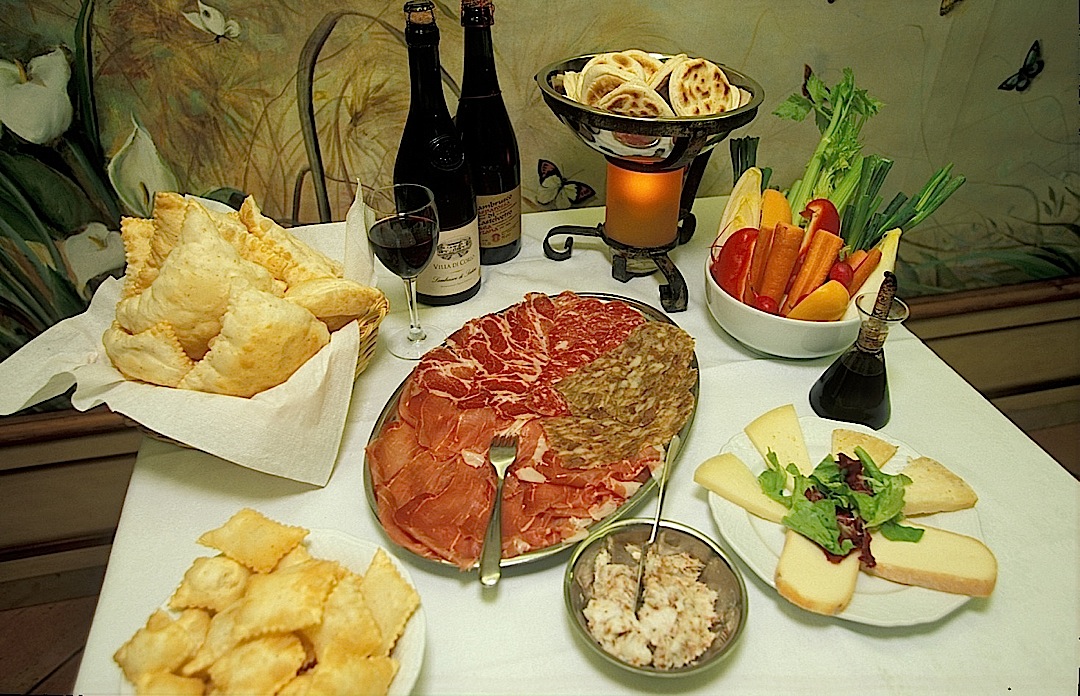 Older texts
gave me no further enlightenment. The
seminal cookbook La Scienza in
Cucina e l’Arte di Mangiare Bene (1891) by
Pellegrino Artusi, born in Forlì in
Emilia-Romagna, contends that the Bolognesi call
their meat sauce a “dark broth,” made by
sautéeing onions, carrot, celery and garlic
with the “poorer-quality cuts” of meat and
“trimmings from the kitchen,” then adding
one-and-a-half quarts of hot water and simmering
it all for five or six hours. Adding
split heads and necks of chickens will improve the
sauce, he says.
Older texts
gave me no further enlightenment. The
seminal cookbook La Scienza in
Cucina e l’Arte di Mangiare Bene (1891) by
Pellegrino Artusi, born in Forlì in
Emilia-Romagna, contends that the Bolognesi call
their meat sauce a “dark broth,” made by
sautéeing onions, carrot, celery and garlic
with the “poorer-quality cuts” of meat and
“trimmings from the kitchen,” then adding
one-and-a-half quarts of hot water and simmering
it all for five or six hours. Adding
split heads and necks of chickens will improve the
sauce, he says.
Confused by all this
questionable dogma, it seemed the best thing for
me to do was to go directly to the source—the
beautiful city of Bologna, long called “Bologna La
Grassa” (“fat Bologna”) for its rich and
lavish food—and find out exactly how the best
cooks in Emilia-Romagna make lasagne
verdi.
This is the region that gave the world
Parmigiano-Reggiano, mascarpone, mortadella, cotechino,
grana padana, Prosciutto di Parma, tortellini,
tagliatelle, and, of course, lasagne all bolognese.
Four days of
eating the dish did
reveal a few things: first, as you probably
expected, I found no “classic” version of the
dish, despite the claims by many cooks that theirs
was the only
correct
way to make it; second, Bologna Grassa has
lightened up its cooking in recent years, so that,
aside from the requisite besciamella,
few now cook the ragù
in milk or add livers, coxcombs, unborn chicken
eggs, nerve ganglia, porcini,
or truffles as they once did; third, despite
devouring so many lasagnes at both lunch and
dinner, I never left the table groaning with
satiety. In
fact, I found the lasagnes were remarkably light,
owing to the extreme thinness of the pasta layers.
Before
leaving for Bologna, I contacted Mary Beth Clark,
an American who runs the International
Cooking School there, for some guidance. She
recommended an array of trattorias—and told me to
stay clear of others—warning me that, “The Bolognesi are very
demanding people, and are very, very critical at
the dining table. Everyone
has an opinion on the proper lasagne, and everyone will
have his or her own version, and of course, it’s
the best! If I may recommend for analysis,
diagnose the layering and the size of the ragù
ingredients.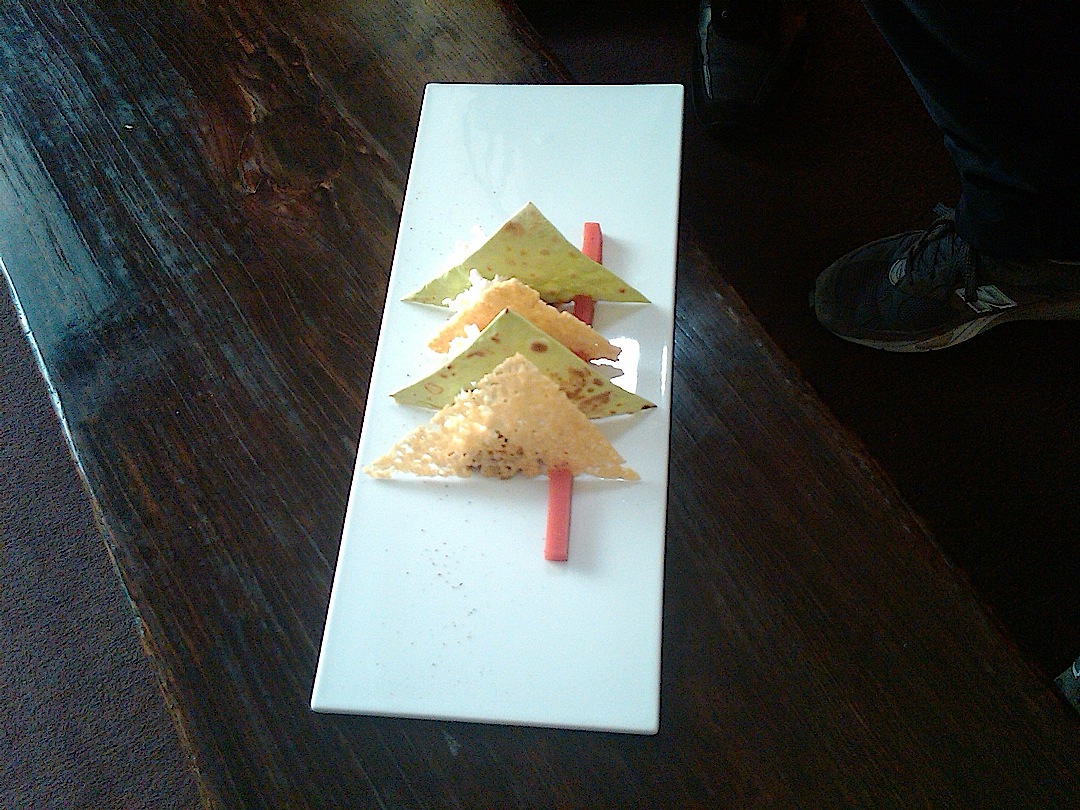 Touch the lasagne in various points on the
top layer – even for heat and oozing besciamella.
Is it still cool in the center? Made fresh that
day or stored and micro-waved? It will be interesting to
hear what the waiters say went into the ragù.”
Touch the lasagne in various points on the
top layer – even for heat and oozing besciamella.
Is it still cool in the center? Made fresh that
day or stored and micro-waved? It will be interesting to
hear what the waiters say went into the ragù.”
Armed with a dizzying amount of
conflicting opinion and recommendations, I flew to
Italy and stopped in the Emilia-Romagnian city of
Modena, where I’ve always wanted to dine at Osteria
Francescana--this year the winner of three
Michelin stars--run by the bearded Chef Massimo
Bottura, whose hyper-creativity is driven by an
intense personal history. So when
I asked him if he served lasagne verdi,
he paused, put his finger to his temple, and
rushed off to the kitchen, returning an hour later
with a plate of what looked like three pastry
triangles. “When I think of lasagne verdi
alla bolognese,” he said with the tone of a
Dominican theologian, “I ask, what part does
everyone love about it? And I remembered by
mother’s lasagne and how I loved the crispy top
that I could eat all on its own. So,
that is what I made for you—a sandwich of crispy
pasta with a little ragù
and besciamella
foam inside” (right).
I didn’t quite
grasp what he was saying about how the sandwiching
acts “like the cooling function of a Ferrari,” but
on the side of the white plate was a thin ribbon
of tomato in commemoration of red Ferraris, which
are manufactured right there in Modena.
I took a bite and stared at
him. “You’re right,” I said. “This is everyone’s
favorite part of lasagne.” Yet
Bottura’s brilliant riff on a classic dish was not
what I was in search of, so I pushed on to
Bologna, whose historic city center is thronged
with ristoranti
and trattorie, which,
despite the summer’s heat, all had lasagne verdi
on their menus.
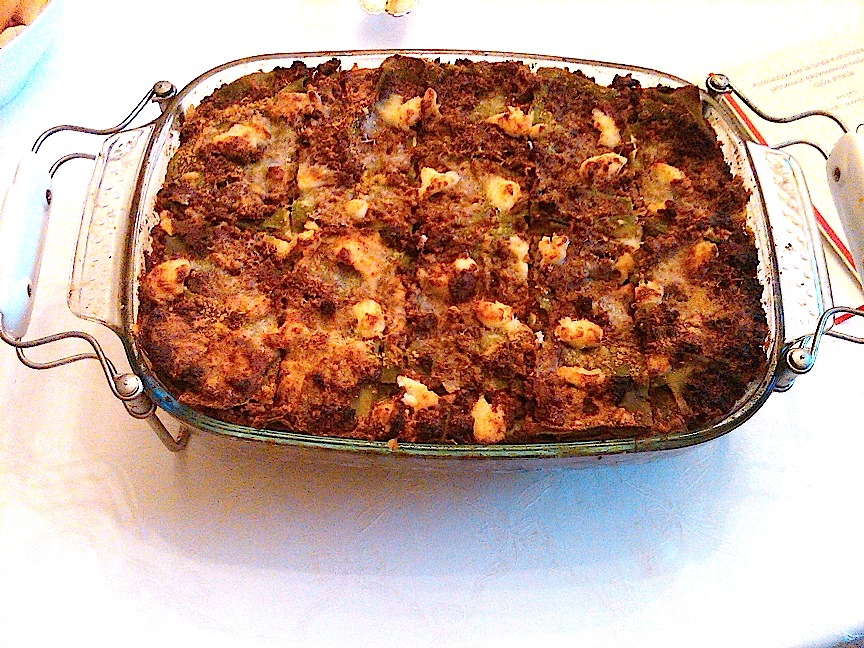 That evening, however, I
ate at the home of Ronnie Venturoli,
a formidable red-headed woman in her seventies who
is the self-proclaimed “regina di
lasagne verdi.” She is part of a program
called Homefood, described as an “Association for
the protection and increase of the value of
typical gastronomic and culinary legacy,” through
which visiting guests to Italy may, as did I, dine
with one of their
home cooks,
called “Le
Cesarine.”
That evening, however, I
ate at the home of Ronnie Venturoli,
a formidable red-headed woman in her seventies who
is the self-proclaimed “regina di
lasagne verdi.” She is part of a program
called Homefood, described as an “Association for
the protection and increase of the value of
typical gastronomic and culinary legacy,” through
which visiting guests to Italy may, as did I, dine
with one of their
home cooks,
called “Le
Cesarine.”
Queen Ronnie, who has a voice
that could cut through a wheel of Parmigiano,
served me two lasagnes, one, her own creation,
made with artichokes—“for summer”--the other lasagne verdi
(left),
for which she uses twelve layers of spinach pasta
rolled out with a long mattarello.
“Dodici
sfoglie! Like the twelve Apostles,” she
said. “I make them so thin you can see [the
mountain of] San Luca through them!” Night had set
in, so I could not test her contention, but these
were indeed exceptionally fine sheets of deep
green pasta.
Ronnie’s ragù was
made with roasted beef, which she adds to the
holy trinity of onions, carrot, and celery and
cooks in water, not fat, which came as a big
surprise, and with a little concentrate of tomato
and a touch of sugar. After simmering it all down
for three hours, she adds some olive oil and cooks
it for three more hours. Then she layers the pasta
sheets, alternately, with ragù and besciamella,
tops it all with Parmigiano and brings it to a
bubbling point when the besciamella
pops through the last sheet of pasta. A
little jetlagged that first night, I went to bed
counting the Twelve Apostles till I fell asleep.
The next morning I attended La Vecchia Scuola
Bolognesi, founded in 1993 by Alessandra
Spisni (below),
a generous, gregarious 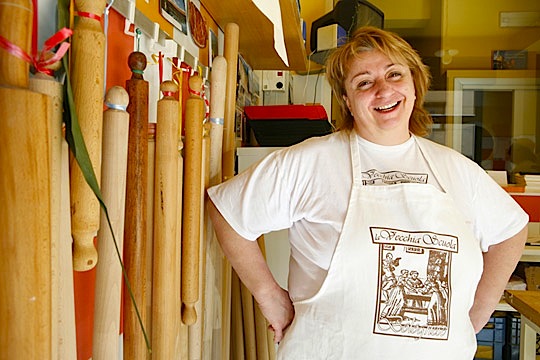 woman
devoted to spreading the gospel of Bolognesi
cuisine, teaching students how to make everything
from lasagne
verdi to tortellini al ragù as well
as how to cut a sheet of pasta into strings truly
as thin as angel’s hair must be. She told me that
in Emilia, Bologna’s region, the pasta is always
made thinner than in Romagna, and that she uses
only beef, never pork, cut from the shoulder and
neck, pushed through a coarse grinder, then
sautéed in strutto (pork fat). She
then turned me over to Chowdhury Ashraf Uddin, who
hails from Bangladesh and was once a student at La
Vecchia Scuola, now a teacher here who disproved
to me the assertion I’d heard elsewhere that only
a true Bolognese can great Bolognese food. I was
running low on cherished beliefs.
woman
devoted to spreading the gospel of Bolognesi
cuisine, teaching students how to make everything
from lasagne
verdi to tortellini al ragù as well
as how to cut a sheet of pasta into strings truly
as thin as angel’s hair must be. She told me that
in Emilia, Bologna’s region, the pasta is always
made thinner than in Romagna, and that she uses
only beef, never pork, cut from the shoulder and
neck, pushed through a coarse grinder, then
sautéed in strutto (pork fat). She
then turned me over to Chowdhury Ashraf Uddin, who
hails from Bangladesh and was once a student at La
Vecchia Scuola, now a teacher here who disproved
to me the assertion I’d heard elsewhere that only
a true Bolognese can great Bolognese food. I was
running low on cherished beliefs.
Uddin
showed me the small but important refinements that
make the school’s version so delicate. He
first hand chops the odori mix
of onion, carrots, and celery—never in a blender,
which extrudes liquid from the vegetables—in strutto
for about 20 minutes or more till the carrots are
cooked through. Without adding any more fat, he
puts the meat in a sauté pan and cooks it
at high heat to brown it, then pours in one cup of
red wine and one or two cups—measured by eye—of
tomato passato
(puree), with a little salt, but no pepper
whatsoever. He adds a cup of water and cooks for
two to three hours.
Meanwhile he makes the besciamella
by quickly thickening 90 grams of butter and 60
grams of flour, then adding one liter of milk and
a scraping of nutmeg, cooked over low heat until
slightly thicker than heavy cream. He
boils the sheets of spinach pasta then dunks them
into salted cold water. He then layers five sheets
of pasta with small amounts of the ragù
and besciamella
on each layer—“not too much of either ingredient,”
he notes—then lavishes the top with Parmigiano,
the completed dish to be baked at 180 degrees for
45 minutes.
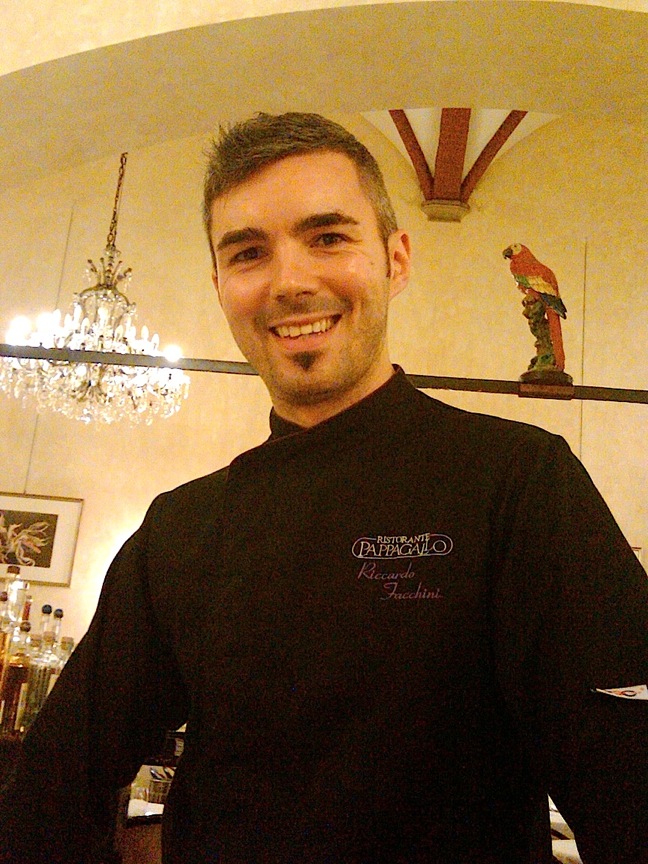 For lunch
that day I returned to a ristorante
I hadn’t visited in twenty years, when it was in
its glory days, a time when every celebrity, from
Gina Lollabrigida and Claudia Cardinale to Sharon
Stone and Lionel Richie, dined here and happily
had their photo added to the walls (below) of the
dining room at Pappagallo.
I had heard, however, that changes in ownership
had tarnished Pappagallo’s reputation, so I was
delighted to find it a better restaurant than
ever, thanks to a brand new, 32-year-old chef
named Ricardo Facchini (left), who has brought delicacy
and new ideas to the traditional dishes that have
always been served here, including, of course, lasagne
verdi.
For lunch
that day I returned to a ristorante
I hadn’t visited in twenty years, when it was in
its glory days, a time when every celebrity, from
Gina Lollabrigida and Claudia Cardinale to Sharon
Stone and Lionel Richie, dined here and happily
had their photo added to the walls (below) of the
dining room at Pappagallo.
I had heard, however, that changes in ownership
had tarnished Pappagallo’s reputation, so I was
delighted to find it a better restaurant than
ever, thanks to a brand new, 32-year-old chef
named Ricardo Facchini (left), who has brought delicacy
and new ideas to the traditional dishes that have
always been served here, including, of course, lasagne
verdi.
His version, which I enjoyed along with a
seafood taglioline
and fritto
misto of meats and vegetables and a chilled
bottle of slightly frizzante Leclisse Lambrusco, was
made with a ragù based on pork, not beef,
chopped with a knife, not ground, cooked in strutto.
“In the old days beef was too expensive, so pork
would have been used,” explained Facchini,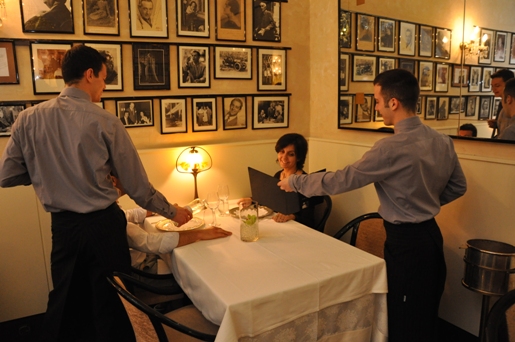 “and
Emilia-Romagna really didn’t use olive oil until
the 1950s. The green of the lasagne was originally
from nettles, but now spinach is used.”
“and
Emilia-Romagna really didn’t use olive oil until
the 1950s. The green of the lasagne was originally
from nettles, but now spinach is used.”
As I’d been hearing again and again, the
aim in modern Bolognese cuisine is to make it
lighter but tastier, with less fat but more flavor
drawn from the best ingredients of the region,
which has a mighty reputation for its eggs,
balsamic vinegar, Parmigiano-Reggiano, Prosciutto
di Parma, and more.Facchini’s version was superb,
the layers thin and artfully cut, the melding of ragù
and besciamella
consistent, and the topping crisp and fragrant
with Parmigiano. I poked: heated through
everywhere.
That evening I dined al fresco at a revered
trattoria named Biassanot,
a dialect word that means, roughly, “night eater,”
and the place was packed at least until eleven
p.m. with people feasting on dishes like roast capretto
with rosemary, gnocchi al
Gorgonzola, and lasagne verdi,
its pasta rolled out very thin and with
considerable pride. This rendering was five layers
in height, creamy but not overflowing with besciamella.
I was beginning to learn that balance, not
ostentatious display, was the key to lasagne verdi
and that the Bolognesi go white at the thought of
putting mozzarella, ricotta, and tomato sauce on
thick layers of pasta as is the case in Southern
Italian lasagne recipes.
 With one day to go,
I balanced the trattoria style with one of great
posh. At
lunch I ate with gusto at Trattoria
Anna Maria, now a quarter century old, where
the appropriately stout owner/chef Anna Maria
Monari (left)
is not happy unless her guests are full and very
happy, and she loves nothing better than to go to
tables and explain every dish ordered and those
she’d like you to try. Like her friggione,
made with onions, green peppers, and tomatoes
cooked down to a chunky condiment perfect with the
flatbread called
piadina.
With one day to go,
I balanced the trattoria style with one of great
posh. At
lunch I ate with gusto at Trattoria
Anna Maria, now a quarter century old, where
the appropriately stout owner/chef Anna Maria
Monari (left)
is not happy unless her guests are full and very
happy, and she loves nothing better than to go to
tables and explain every dish ordered and those
she’d like you to try. Like her friggione,
made with onions, green peppers, and tomatoes
cooked down to a chunky condiment perfect with the
flatbread called
piadina.
Anna Maria’s
lasagne,
which is made daily and never reheated, begins
with a ragù
made with pancetta,
thinly sliced lardo,
two parts pork shoulder, one part beef, the former
cooked first, the latter afterwards, in peanut
oil. She
adds half a glass of milk and cooks it until it is
absorbed, and, along with the odori of
onion, carrot, and celery, and adds a bit of
tomato concentrate, stirred in over a low flame. The ragù is
cooked slowly for three hours till the fat comes
to the top.
She adds salt and
pepper, but no wine. “Wine is for drinking,” she
says. “It’s
an old farmer’s tradition in my home of Sasso
Marconi that children shouldn’t eat food with wine
in it.”
I tasted the fragrant ragù
on its own, deeply flavorful with only a hint of
tomato and a perfect equilibrium of fat to lean in
the meat, which is chunkier than other versions
I’d had. The
pasta layers number five, and they were,
surprisingly, yellow-white, not green. “I use very
little spinach,” said Annamaria, “and not too much
besciamella.
Lasagne used to be a Sunday dish and was made with
seven layers, a holy, symbolic number. Nowadays,
we make it lighter, with just five.” I finished
off with an Emilia-Romagna signature dessert, zuppa
inglese, and began thinking about my last
dinner in Bologna.
I had been staying at the very well-named Majestic Hotel,
so I dined there that evening in their splendidly
decorated 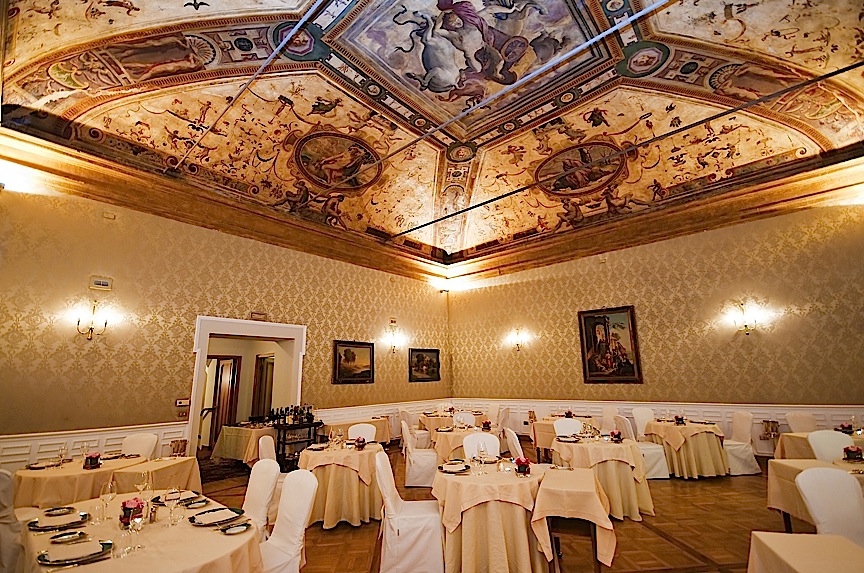 ristorante
named I Carracci (right), named after the
Bolognese family of baroque painters. There,
sitting at a beautifully set table within walls
faced with silk, beneath a gorgeous ceiling
fresco, and served by a staff who seem to have an
impeccable sense of pacing for my meal, I dined
leisurely, beginning with a cup of cool gazpacho
with whipped robiola
and sea asparagus, then a plate of sliced culatello with
toasted brioche, followed by the inevitable, and
last, lasagne verdi.
ristorante
named I Carracci (right), named after the
Bolognese family of baroque painters. There,
sitting at a beautifully set table within walls
faced with silk, beneath a gorgeous ceiling
fresco, and served by a staff who seem to have an
impeccable sense of pacing for my meal, I dined
leisurely, beginning with a cup of cool gazpacho
with whipped robiola
and sea asparagus, then a plate of sliced culatello with
toasted brioche, followed by the inevitable, and
last, lasagne verdi.
After all the versions—homemade,
schoolmade, traditional and eccentric, lasagnes
with boiled beef, sauteed pork, red wine, no wine,
twelve layers, five layers, but never any
garlic--I still found that when I became hungry
each day and evening, the idea of another portion
of this dish that I’d found in so many variants
was still a welcome surprise. The
flavors of the ragù,
some with nutmeg, some without pepper, some spread
with besciamella,
others just dotted, still made for a distinct
taste always identifiable as lasagne verdi
alla bolognese but different enough to show
the personal touch of those who made them.
I Carracci’s lasagne was the most beautiful
of them all.
It came in the round shape of an individual
torta,
its layers folding inward, and it was set in a
little pool of remarkably light Parmigiano fondue,
just enough for each bite. When the captain came
to ask how I enjoyed it, he eyed my clean plate
and said, “Ah, the dish is talking for you.”
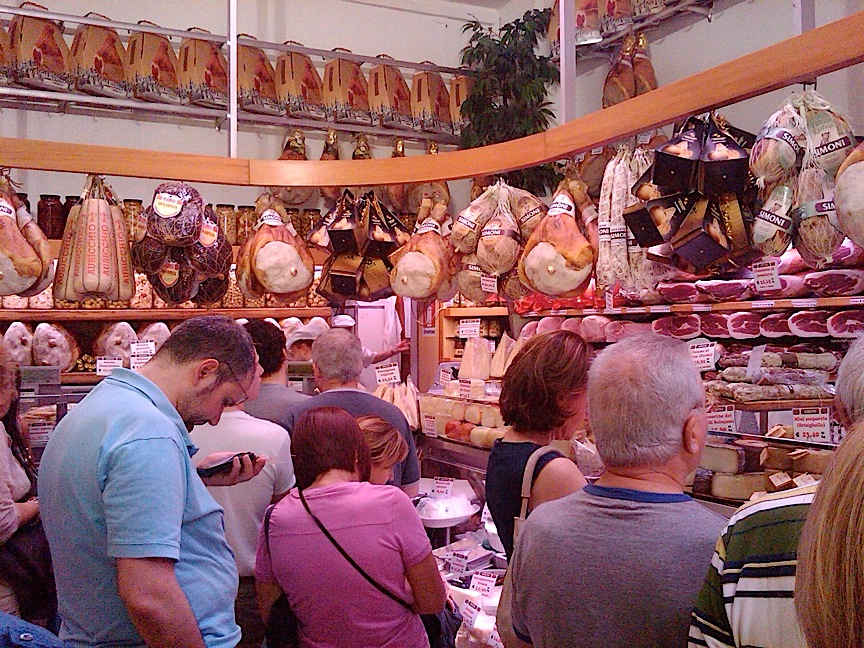 While
I was ferreting out the best lasagne in Bologna, I
took in the city's food culture, which is very
rich and very well dispersed throughout the city,
including a wonderful food market venue called Via
Pescerie Vecchie--The Old Fish Street--lined with
bakeries, fresh pasta shops, chocolate shops,
salumeria, seafood stores, and trattorias. At
Aperi they serve only crudi, uncooked seafood.
At Il
Sole (below),
the chalkboard menu outside lists all the fish of
the day and people sit at communal tables and eat
whatever the kitchen sends out, with a degustation
of seafood, all brought in that morning, all
at a remarkably low price. At Simoni
(left),
the city's best salumeria, the walls are hung with
fat prosciutti,
the glass
While
I was ferreting out the best lasagne in Bologna, I
took in the city's food culture, which is very
rich and very well dispersed throughout the city,
including a wonderful food market venue called Via
Pescerie Vecchie--The Old Fish Street--lined with
bakeries, fresh pasta shops, chocolate shops,
salumeria, seafood stores, and trattorias. At
Aperi they serve only crudi, uncooked seafood.
At Il
Sole (below),
the chalkboard menu outside lists all the fish of
the day and people sit at communal tables and eat
whatever the kitchen sends out, with a degustation
of seafood, all brought in that morning, all
at a remarkably low price. At Simoni
(left),
the city's best salumeria, the walls are hung with
fat prosciutti,
the glass 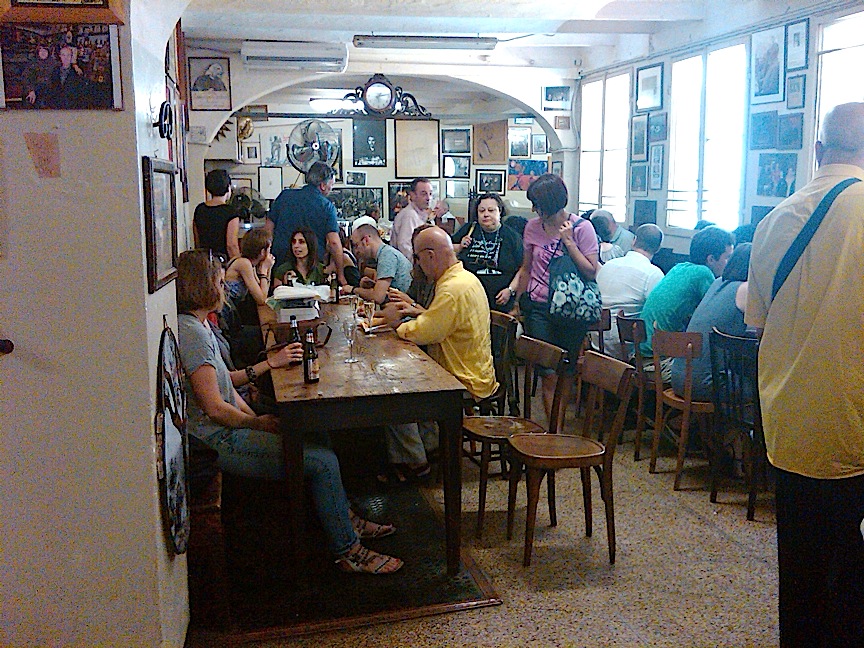 cases
lavished with dozens of salume, and the place is packed
from the moment it opens, with Bolognesi lined up
to buy their daily supply of the meats that make
Emilia Romagna so famous.
cases
lavished with dozens of salume, and the place is packed
from the moment it opens, with Bolognesi lined up
to buy their daily supply of the meats that make
Emilia Romagna so famous.
I passed an al fresco trattoria
(below)
where tables were filled with charming young
Bolognesi students who just got out of classes for
the long lunch that is part of the Italian
culture. They were feasting on prosciutti
and bread, olive oil and pastas, cheese and red
wine. Then I thought at the ubiquitous awfulness
of school cafeteria food and fast food eateries on
American campuses. It was a perfect
dichotomy to describe why Italians choose to enjoy
life to the fullest at every opportunity.
Maybe someday I'll send 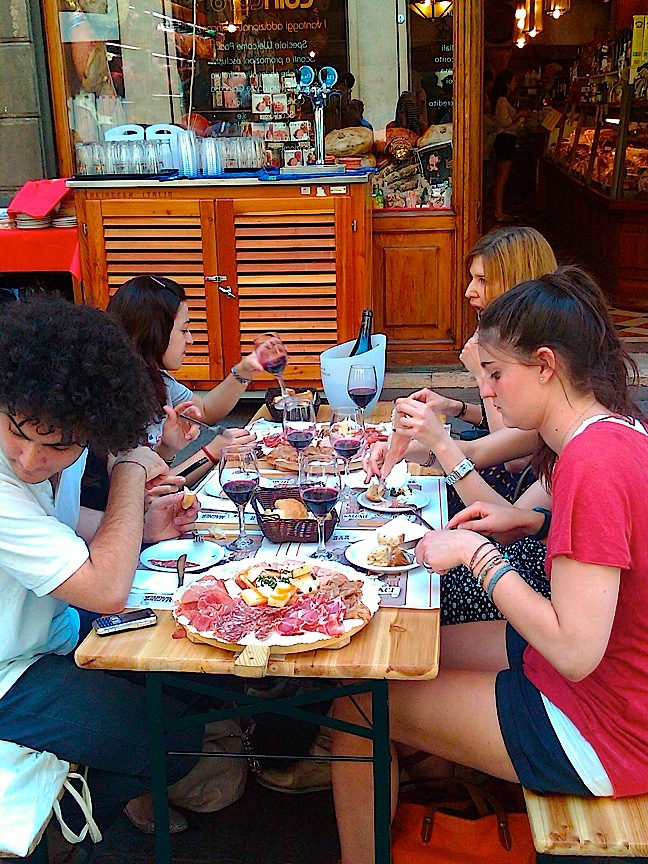 my grandchildren to the
University of Bologna.
my grandchildren to the
University of Bologna.
The
next
day, flying back to the States, I thought about
all the lasagnes I’d tasted and the recipes I was
brining back, and I realized that, with the
exception of the wildly fanciful version I had at
Osteria Francescana, just about any of them would
make a lasagne I proudly could serve my own guests
and pronounce it to be a very typical example of
how they do it in Bologna. I could
hardly wait to get home and cook.
As the plane took off, I
reclined my seat, opened the newspaper and read
that a restaurant in Krakow, Poland, had just set
a Guinness World Record for cooking the biggest
lasagne ever, weighing 4,800 kilograms, cooked for
ten hours, and sliced into 10,000 portions. The
report didn’t given a recipe, but I thought it was
a nice touch that the restaurant made it in the
town square for the visiting Italian football
team.
❖❖❖
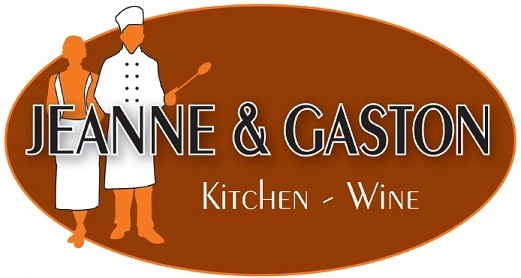
212 West 14th Street (near 7th Ave.)
212-
675-3773
www.jeanneandgaston.com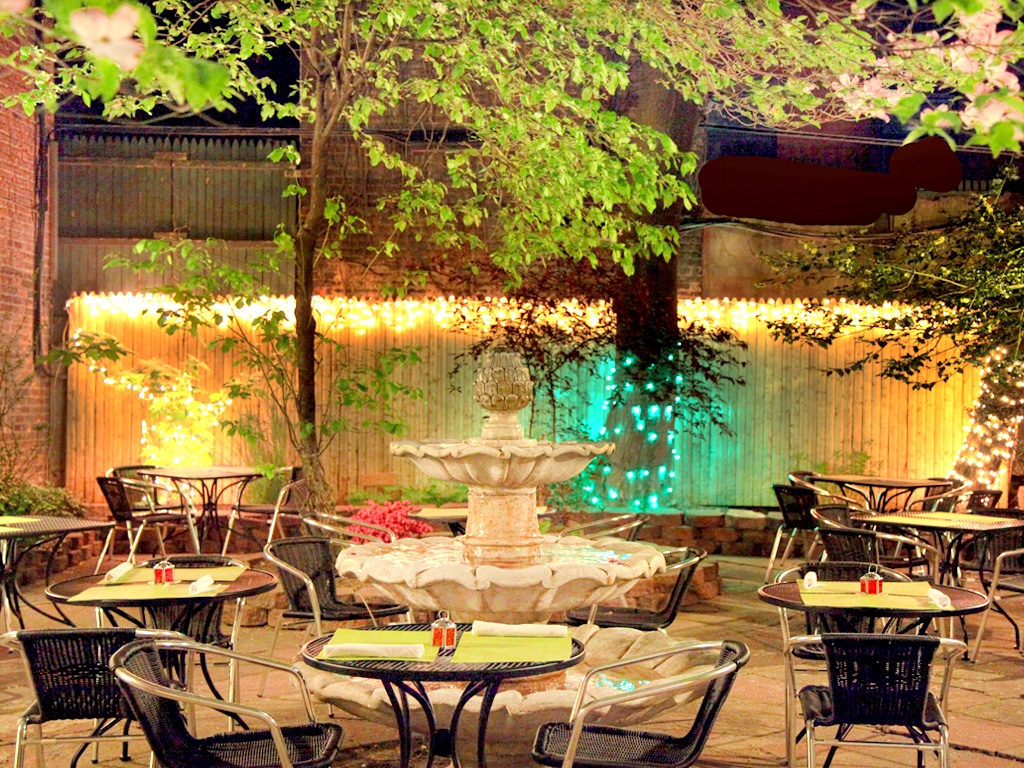
My
affection for the French bistro, especially those
built on the maman-et-papa
traditions of homey hospitality and devotion to
regional classics was once again brought into sweet
focus at Jeanne & Gaston, a new bistro in West
Greenwich Village, when owner Claude Godard is paying
homage to his grandmother and grandfather who ran a
bistro in Vichy before the war.
Godard also runs Madison Bistro on
Madison Avenue and 37th Street, with a very similar
menu of those kinds of French classics that never go
out of favor. Jeanne & Gaston has all the
coziness you might require in the dining room (below), with its
mahogany wood and tiled floor, and its pressed tin
ceiling, wine cabinet and French windows, but the real
attraction--at least till it gets too cold--is the
40-seat enclosed garden area (right) where my guests and I sat for
a long autumn dinner. The space is landscaped
with potted plants, dogwood trees, a wooden fence,
wrought iron and rattan tables, and a gurgling
limestone fountain.
 One cannot fail
to order certain totemic dishes in a bistro, and onion
soup au gratin
is one of them. Godard's version is textbook, rich,
deep brown, the onions sweet, the Gruyère
lavish and bubbly on top, not too much bread and a
deeply-flavored broth. Duck foie gras and peas parfait
was delightful, light but rich, and a vibrant gazpacho
(below) comes
with tender calamari and zucchini strips, the last bonne soupe of
summer. There is a delicate napoleon of sweet crabmeat
with avocado and a touch of lemongrass to perk the
flavors up. Godard, who is from
One cannot fail
to order certain totemic dishes in a bistro, and onion
soup au gratin
is one of them. Godard's version is textbook, rich,
deep brown, the onions sweet, the Gruyère
lavish and bubbly on top, not too much bread and a
deeply-flavored broth. Duck foie gras and peas parfait
was delightful, light but rich, and a vibrant gazpacho
(below) comes
with tender calamari and zucchini strips, the last bonne soupe of
summer. There is a delicate napoleon of sweet crabmeat
with avocado and a touch of lemongrass to perk the
flavors up. Godard, who is from 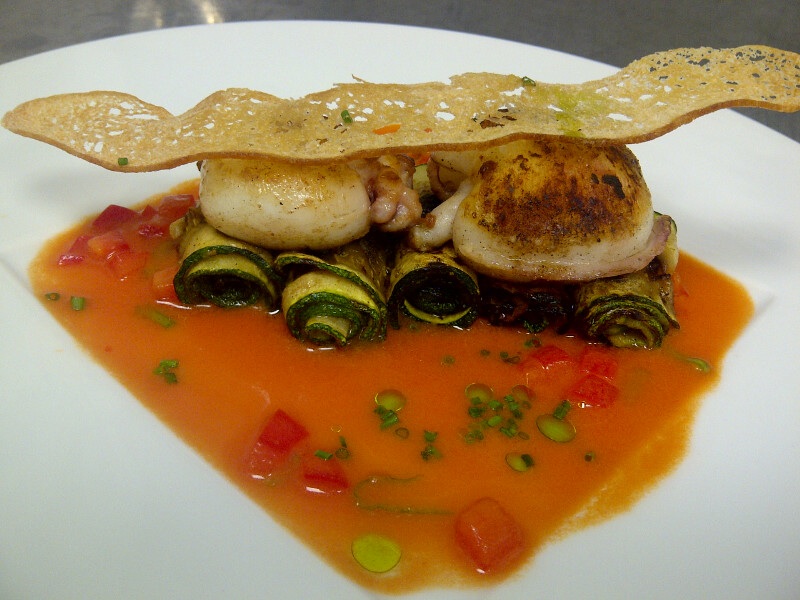 Burgundy, sent
out a dish that was once ubiquitous in NYC French
restaurants, now rarely seen--quenelles of pike, airy,
light poached dumplings in a rich cream sauce (which
separated a little that night).
Burgundy, sent
out a dish that was once ubiquitous in NYC French
restaurants, now rarely seen--quenelles of pike, airy,
light poached dumplings in a rich cream sauce (which
separated a little that night).
For
entrees--all a remarkable $26--I heartily recommend
sea scallop Tarte Tatin Provençale, very homey,
very good. Steak frites has the right chewiness and
the pommes frites were fought over at our table. Are
there ever enough? Short ribs here, done in a
red wine bourguinonne reduction, was the first great
cold weather dish I've enjoyed so far this year.
Desserts are not exceptional but
good to clinch the bistro theme at meal's end--apricot
and almond tart Grande-Mére Jeanne; a vanilla
crème brûlée with lemon cookie
spoon; and one of my favorite old-fashioned items,
floating island, the featherweight poached egg whites
in a vanilla-rich créme anglaise.
No city, not even Paris--where old
bistros have been going out of business at an alarming
rate--can ever have enough of these sweet reminders of
Gallic hospitality and good food, served without
pretense, offered with heart.
by Brian Freedman
 Few
beverages are as misunderstood as those we
traditionally drink after a meal. Even mention of
dessert wines, sweet wines, or digestifs often
conjures up almost comically antiquated images of
monocle- and ascot-clad men of means retiring to the
library after a baroque meal of endangered species’
flesh, smoking pipes and divvying up their interests
on large maps of the colonies.
Few
beverages are as misunderstood as those we
traditionally drink after a meal. Even mention of
dessert wines, sweet wines, or digestifs often
conjures up almost comically antiquated images of
monocle- and ascot-clad men of means retiring to the
library after a baroque meal of endangered species’
flesh, smoking pipes and divvying up their interests
on large maps of the colonies.
Of course, like most stereotypes, the
post-prandial-drinks one has precious little to do
with reality. And fortunately, the popularity of these
often sweet treats seems to be on the rise. It only
makes sense: Port and ice wine and Cognac and the rest
are often among the most deliriously delicious you can
drink.
This is a great time of year to take advantage
of them. The almost magical warming qualities of, say,
a glass of Port, or the pleasant sizzle of contentment
that a snifter of Cognac sends through your system,
are exactly what we all could use as the mercury
begins its long, inevitable dip towards winter.
Of course, there’s nothing wrong with treating
yourself to these drinks in the warmer months either.
Last September, I spent a week in the Douro Valley,
the home of the grapes that, by an almost alchemy-like
process, are turned into Port. It’s hot over there,
the sun slashing down from seemingly right overhead.
And yet I had no problem drinking more Port than I
ever had before. And here’s the thing: It was perfect,
even in the midday sun. (Especially when just the
slightest bit chilled...which more people should do on
this side of the Atlantic. But that’s another column
for another time.)
Here, then, are some of my favorite sweet wines
and digestifs right now. They’re all perfect both on
their own or after a meal. No matter what the
temperature is outside.
Inniskillin
Riesling Ice Wine 2008 (Niagara Peninsula, Canada)
This is a gorgeous shimmering gold color, with
aromas that float around the glass even before you get
your nose in it. Scents of yellow and white peaches,
nectarines, mandarin orange, and yellow-plum pudding
are complicated by a hint of smoke, spice, and
flutters of honey suckle and honey. 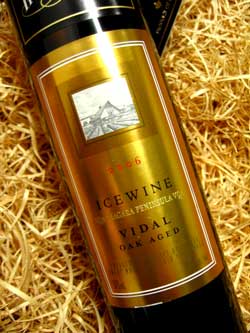 On the palate,
flavors of orange liqueur and lemon verbena are given
vivacity with gorgeous acidity, all of this carried on
a texture that’s nothing short of silken.
On the palate,
flavors of orange liqueur and lemon verbena are given
vivacity with gorgeous acidity, all of this carried on
a texture that’s nothing short of silken.
Inniskillin
Vidal “Gold” Ice Wine 2007 (Niagara Peninsula,
Canada)
Lemon crème
and lemon verbena combine with kaffir lime leaf and
hints of lemongrass on this subtly aromatic, wildly
complex nose. These turn to flavors of spicy,
concentrated orange and kumquat notes, as well as
passion fruit preserves. What a joy to drink: Unique,
expressive, and delicious.
Kracher
Auslese Cuvee 2008 (Burgenland, Austria)è
Aromas of honey and tahini, cooked rice, and
other ineffably complex, unexpectedly savory notes set
this apart immediately and demand your attention. On
the palate, mushrooms cooked down in honey, a
lingering sense of spiciness, and subdued acidity that
still brings the wine freshness mingle with apricot
skin and lemon-blossom honey. Exceptionally
interesting and thoroughly successful.
W and J
Graham’s Quinta dos Malvedos Vintage Port 2009
(Portugal)
Beguiling glass-staining color, all deep purple
and bruise-like. Beautiful. On the nose, a notably
spicy aroma leads the way to notes of crushed dark
cherries, black raspberries and blackberries, Baker’s
Chocolate, and café mocha. These turn to long,
concentrated, layered flavors of plum pudding,
black-cherry cobbler and pipe tobacco, hints of cedar,
and minerals, and evolve to a finish that turns a bit
exotic with flashes of sandalwood, 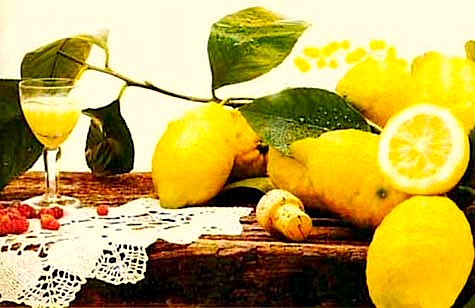 cardamom, and scorched earth alongside
the berry fruit and baking spices. Excellent now, this
will continue to evolve for another two decades.
cardamom, and scorched earth alongside
the berry fruit and baking spices. Excellent now, this
will continue to evolve for another two decades.
Limoncello
di Capri (Italy; Organic)
Beautiful floral-honey note to the bright,
expressive, fresh-lemon nose. The alcohol lends it a
hint of spice, as well as subtle white licorice
aromas, and the palate shows a velvety, viscous
texture. The initial sweetness, which follows
throughout, is balanced out by acidity and that
alcohol spiciness. Great alone, or with a baked
ricotta or a not-terribly-sweet cannoli.
❖❖❖
YOU BE
THE JUDGE!!!!

"As we drove down the broad stretch of Highway 9,
which, under its guise as State Street, forms the main
thoroughfare of Hurricane, Utah, my 14-year-old
confided that he found the girl on the illuminated
Wendy’s sign `disturbing'. I can see his point: with
her ketchup-red hair and pigtails akimbo; with the
upstanding and presumably savagely starched piecrust
collar of her shirtwaist; with her stylised freckles
and unbelievably joyful smile, the Wendy’s girl (who,
one can only assume, is the eponymous “Wendy”) has the
same sinister aura of other humans-gone-logo. Still,
she’d probably give that creepy Colonel Sanders a
thrashing while beating up on that
Chucky-doll-lookalike, Ronald McDonald, with a handy
rolling pin."
--Will Self, "Branding is more
fundamental to the US psyche than the Bible," The New Statesman.
 POLICE SENT OUT AN
ALL-POINTS-BULLETIN
POLICE SENT OUT AN
ALL-POINTS-BULLETIN
TO LOOK FOR A
FAT, FRECKLED, RED-HEADED JAPANESE MAN
NYC Police finally caught and the court convicted
a man for a string of restaurant thefts in which he
tunneled through the wall of an apartment into the
basement of Kyotofu restaurant where he filled two
bags full of Jameson's Irish Whiskey, sake, and a
large slab of pork belly.
❖❖❖
Any of John Mariani's
books below may be ordered from amazon.com.
 |
My latest book, which just won the prize for best book from International Gourmand, written with Jim Heimann and Steven Heller, Menu Design in America, 1850-1985 (Taschen Books), has just appeared, with nearly 1,000 beautiful, historic, hilarious, sometimes shocking menus dating back to before the Civil War and going through the Gilded Age, the Jazz Age, the Depression, the nightclub era of the 1930s and 1940s, the Space Age era, and the age when menus were a form of advertising in innovative explosions of color and modern design. The book is a chronicle of changing tastes and mores and says as much about America as about its food and drink.
“Luxuriating vicariously in the pleasures of this book. . . you can’t help but become hungry. . .for the food of course, but also for something more: the bygone days of our country’s splendidly rich and complex past. Epicureans of both good food and artful design will do well to make it their coffee table’s main course.”—Chip Kidd, Wall Street Journal.
“[The menus] reflect the amazing craftsmanship that many restaurants applied to their bills of fare, and suggest that today’s restaurateurs could learn a lot from their predecessors.”—Rebecca Marx, The Village Voice. |
"Eating Italian will never be the same after reading John Mariani's entertaining and savory gastronomical history of the cuisine of Italy and how it won over appetites worldwide. . . . This book is such a tasteful narrative that it will literally make you hungry for Italian food and arouse your appetite for gastronomical history."--Don Oldenburg, USA Today. "Italian
restaurants--some good, some glitzy--far
outnumber their French rivals. Many of
these establishments are zestfully described
in How Italian Food Conquered the World, an
entertaining and fact-filled chronicle by
food-and-wine correspondent John F.
Mariani."--Aram Bakshian Jr., Wall Street
Journal.
"Equal parts
history, sociology, gastronomy, and just
plain fun, How Italian Food Conquered the
World tells the captivating and delicious
story of the (let's face it) everybody's
favorite cuisine with clarity, verve and
more than one surprise."--Colman Andrews,
editorial director of The Daily
Meal.com. "A fantastic and fascinating
read, covering everything from the influence
of Venice's spice trade to the impact of
Italian immigrants in America and the
evolution of alta cucina. This book will
serve as a terrific resource to anyone
interested in the real story of Italian
food."--Mary Ann Esposito, host of PBS-TV's
Ciao
Italia. "John Mariani has written the
definitive history of how Italians won their
way into our hearts, minds, and
stomachs. It's a story of pleasure over
pomp and taste over technique."--Danny Meyer,
owner of NYC restaurants Union Square Cafe,
Gotham Bar & Grill, The Modern, and
Maialino.
|
 |
 |
 |
 |
 |
 |
 |
 |
 Everett Potter's Travel Report:
Everett Potter's Travel Report: 
 Eating Las Vegas
is the new on-line site for Virtual Gourmet
contributor John A. Curtas., who since 1995
has been commenting on the Las Vegas food
scene and reviewing restaurants for Nevada
Public Radio. He is also the
restaurant critic for KLAS TV, Channel 8 in
Las Vegas, and his past reviews can be
accessed at KNPR.org.
Click on the logo below to go directly to
his site.
Eating Las Vegas
is the new on-line site for Virtual Gourmet
contributor John A. Curtas., who since 1995
has been commenting on the Las Vegas food
scene and reviewing restaurants for Nevada
Public Radio. He is also the
restaurant critic for KLAS TV, Channel 8 in
Las Vegas, and his past reviews can be
accessed at KNPR.org.
Click on the logo below to go directly to
his site.

Tennis Resorts Online: A Critical Guide to the World's Best Tennis Resorts and Tennis Camps, published by ROGER COX, who has spent more than two decades writing about tennis travel, including a 17-year stretch for Tennis magazine. He has also written for Arthur Frommer's Budget Travel, New York Magazine, Travel & Leisure, Esquire, Money, USTA Magazine, Men's Journal, and The Robb Report. He has authored two books-The World's Best Tennis Vacations (Stephen Greene Press/Viking Penguin, 1990) and The Best Places to Stay in the Rockies (Houghton Mifflin, 1992 & 1994), and the Melbourne (Australia) chapter to the Wall Street Journal Business Guide to Cities of the Pacific Rim (Fodor's Travel Guides, 1991).


MARIANI'S VIRTUAL GOURMET
NEWSLETTER is published weekly. Editor/Publisher: John
Mariani.
Contributing Writers: Christopher Mariani, Robert Mariani,
John A. Curtas, Edward Brivio, Mort Hochstein,
Suzanne Wright, and Brian Freedman. Contributing
Photographers: Galina Stepanoff-Dargery,
Bobby Pirillo. Technical Advisor: Gerry McLoughlin.
© copyright John Mariani 2012
